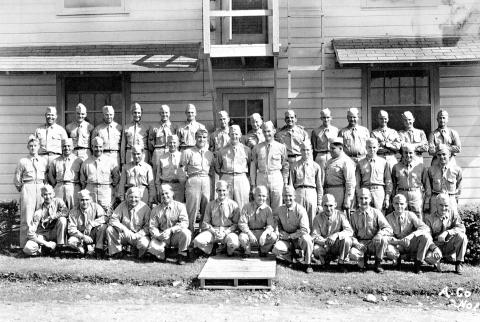
In many ways, the postwar years of Felipe L. Cantú represent a quintessential profile of a World War II veteran, quietly resuming his life, but with a modest hesitancy to discuss combat experiences or express his feelings. In many other ways, however, Cantú’s story is atypical: a journalist who wrote vividly of the war and an artist whose works include scenes from the front lines.
His family was never able to get him to open up about his wartime experiences. Often, he’d dismiss such talk as dwelling on the past when he preferred to look toward the future. For insight, his family turned to the military mementos -- his honorable discharge certificate and other documents, his awards and medals and old newspaper clippings -- he kept in a wooden box.
Cantú was born August 23, 1919, in Agualeguas, Nuevo Leon, Mexico, and moved to San Antonio, Texas, at a young age with his family. Although born in Mexico, he became a United States citizen as a boy.
His hunting skills, coupled with his parents' small farm, shielded the family from the harsh effects of the Great Depression. Cantú would often talk about hunting rabbits in the barren fields that abounded in San Antonio when he was growing up, fields now occupied by commercial and residential development.
Although he didn’t know it at the time, his ease with a rifle would serve him well in the military.
With the U.S. engaged in war, Cantú volunteered for the Army. He was inducted Sept. 23, 1942, to serve in the South Pacific. Teletype Operator was his wartime occupation, and he was a member of Company A of the 16th Signal Battalion.
The few times he spoke of his experiences, he described himself as a "grunt," usually following closely behind tanks as they made their way into enemy territory. His discharge papers give more specifics, describing him as a rifle marksman who participated in several key campaigns, among them New Guinea, the Bismarck Islands and battles in Luzon and Leyte, which led to the liberation of the Philippines.
For his efforts, Cantú earned several commendations: among others, numerous service ribbons, a Good Conduct Medal, an American Theater Campaign Medal, Asiatic Pacific Theater Medal, Meritorious Unit Award and, from the Philippines, Liberation Victory Medal. He was honorably discharged Nov. 29, 1945, having achieved the rank of Technician Fifth Grade.
Before and after the war, he worked as a newspaper writer for La Prensa, the then-dominant, Spanish-language newspaper. By virtue of his experiences, he was given a column titled "From Reporter to Soldier," giving readers a first-person account of what he’d seen during the war. The column was a departure from traditional ones, in which writers are given tight spaces in which to write. Instead, Cantú was allowed to write freely on entire pages devoted to his work, complete with vintage wartime photographs.
"The suffering endured by soldiers serving in the South Pacific can never be understood by those who are unfamiliar with those places," he wrote in one column describing the isolation of the New Guinea jungles. "Some soldiers, mentally weakened, were unable to endure the terrible conditions in those remote places, later going crazy and returning to the United States to be put under the care of doctors. But those instances were few, and most of the soldiers acclimated themselves to the silence and solitude that reach extreme measures in those places."
Other columns detailed the battles at Leyte and Luzon, his receiving word of the surrender of the Japanese, and his unit's arrival in Japan after the surrender. For the last, Cantú departed the Philippines and arrived at Wakayama Bay on Oct. 28, 1945, en route to Kyoto.
Despite the sometimes-graphic accounts of combat life in the columns, Cantú was an optimistic man, gifted with a keen sense of humor. He also was a voracious reader who kept up with current events of the time. The latter penchant was particularly useful in his professional life as a writer and, later, as a radio news broadcaster for the venerable San Antonio-based Spanish-language station KCOR-AM.
In addition to his columns, Cantú created watercolor paintings he composed during the war. An amateur artist, he painted several scenes during the quieter times of war. In more than a dozen small paintings, he depicted a variety of scenes from the South Pacific.
Cantú married soon after the war, and he and his wife had two children before divorcing. Years later, he met Celia Palacios in Mexico City during one of his business trips to Televisa, the Mexican television network where she worked, and they began dating. Despite a significant age difference (she was 24 and he was 45), they married in 1965 and had six children: three boys and three girls.
Cantú later worked in public relations and advertising. In 1968, he was put in charge of Spanish-language publicity for HemisFair '68 in San Antonio, which showcased the city to an international audience. Running from April 6 to Oct. 6, 1968, HemisFair '68 was the first officially designated international exposition in the Southwestern U.S., staged to commemorate the 250th anniversary of the founding of San Antonio.
Cantú later became something of a pioneer in the area of marketing to U.S. Latinos, creating the Spanish-language creative division at Bloom Advertising Agency in Dallas, Texas, in the early 1980s. He and his family returned to San Antonio in 1985, where he continued to work as a freelance copywriter for many companies and organizations, including the Boy Scouts of America and Libby's Nectars.
In 1988, he was diagnosed as having cancer and died in December of that year. Although modest in life, his funeral at Fort Sam Houston in Texas, where he is buried with full military honors and a special flag that was presented to his widow, confirmed his status as an American hero.
Tribute by Narratives Guest Editor Tony Cantú, son of the late Felipe L. Cantú.

